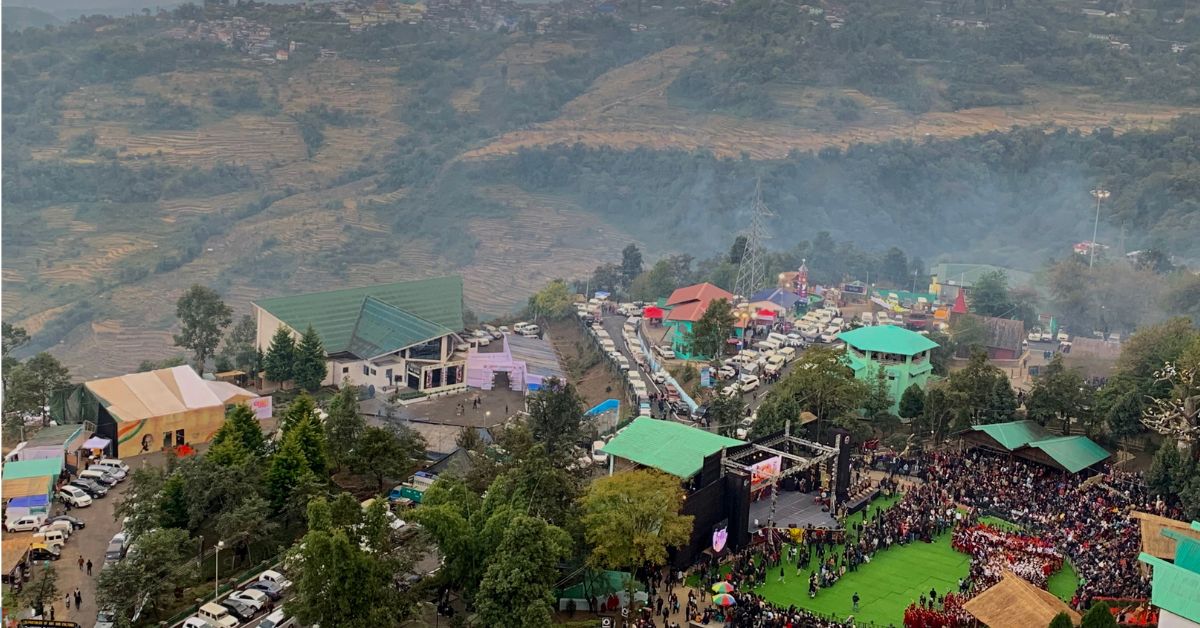Tucked away in Nagaland’s lush green hills, Kisama Heritage Village is a window into the fascinating world of Naga tribes. Just a hop, skip, and a jump from the busy town of Kohima, Kisama feels like a living museum come to life. Here, you can dive into the rich traditions, customs, and stories of the Naga people.
Built to protect and share Nagaland’s diverse heritage, Kisama is famous for its traditional houses, amazing carved poles, and exciting festivals. The village’s biggest claim to fame is being the home of the annual Hornbill Festival – a giant celebration that attracts people from all over India and beyond. During the festival, Kisama explodes with life, showcasing traditional dances, music, crafts, and delicious local food.
How to reach:
By Air
- The closest airport is Dimapur Airport (DIM), located approximately 75 kilometers away.
- From Dimapur Airport, you can hire a taxi or rent a car to drive to Kisama. The journey takes around 2 to 3 hours, depending on traffic and road conditions.
By Train
- The nearest major railway station is at Dimapur, about 75 kilometers from Kisama.
- From Dimapur Railway Station, taxis and buses are available to take you to Kisama. The drive from Dimapur Railway Station to Kisama takes around 2 to 3 hours.
By Road
- Kisama Heritage Village is located about 12 kilometers from Kohima, the state capital. You can easily reach Kisama by taxi or local bus. The drive takes approximately 30 minutes.
- From Dimapur, take National Highway 29 (NH29) to Kohima, and then follow local roads to Kisama.
By Bus
- Local buses run from Dimapur and Kohima to Kisama. In Kohima, you can catch a local bus or shared taxi to Kisama.
best time to visit:
1. Hornbill Festival (December):
- Dates: December 1st to 10th (typically)
- Experience: The peak season! Immerse yourself in the electrifying Hornbill Festival, dubbed the “Festival of Festivals.” Witness traditional dances, music, crafts, and local cuisine in a vibrant celebration of Naga culture.
2. Post-Monsoon Season (October to November):
- Weather: Pleasant with cooler temperatures and less humidity after the monsoon ends in September.
- Experience: Perfect for exploring Kisama at a slower pace, without the festival crowds. Enjoy the lush green landscapes and delve into the cultural offerings.
3. Spring and Early Summer (March to May):
- Weather: Mild temperatures and comfortable weather for outdoor activities.
- Experience: Ideal for a quieter visit with fewer tourists. Soak in the village’s traditional charm and connect with the local culture in a relaxed atmosphere.
4. Monsoon Season (June to September):
- Weather: Expect heavy rainfall, leading to slippery roads and potential travel issues.
- Experience: While the monsoon brings vibrant greenery and a refreshing atmosphere, it might not be the best time to visit due to potential flooding and challenging travel conditions.
attractions:
Hornbill Festival:
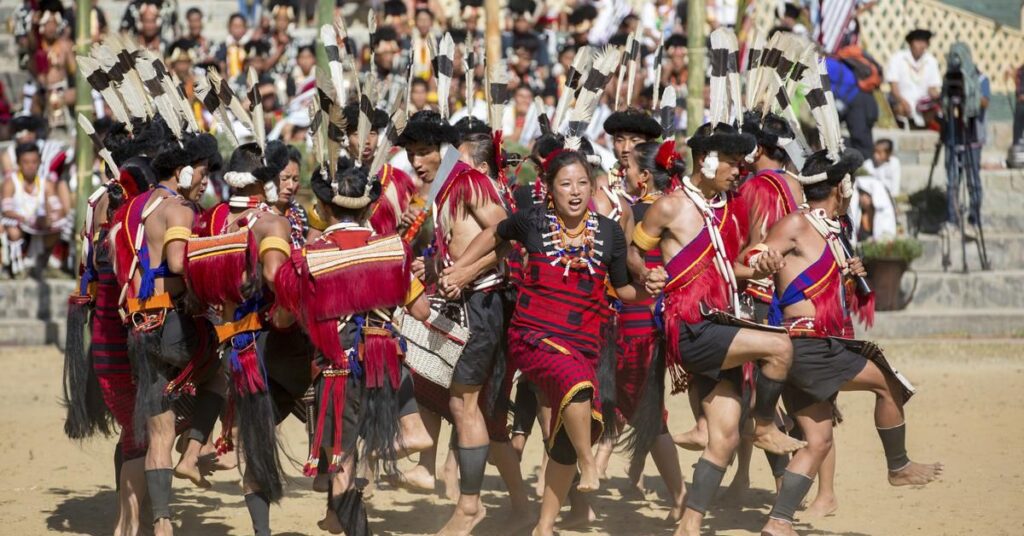
Every year, from December 1st to 10th, Kisama Heritage Village explodes with color and energy during the Hornbill Festival. This incredible event, nicknamed the “Festival of Festivals,” is a giant celebration of everything Naga culture! People come from all over India and even the world to experience the magic. Kisama turns into a bustling hub where traditional dances come alive. Imagine seeing powerful routines with amazing costumes and hearing the beat of drums and tunes from local instruments. There’s even music played on special, one-of-a-kind instruments you won’t find anywhere else!
Traditional Naga Huts:
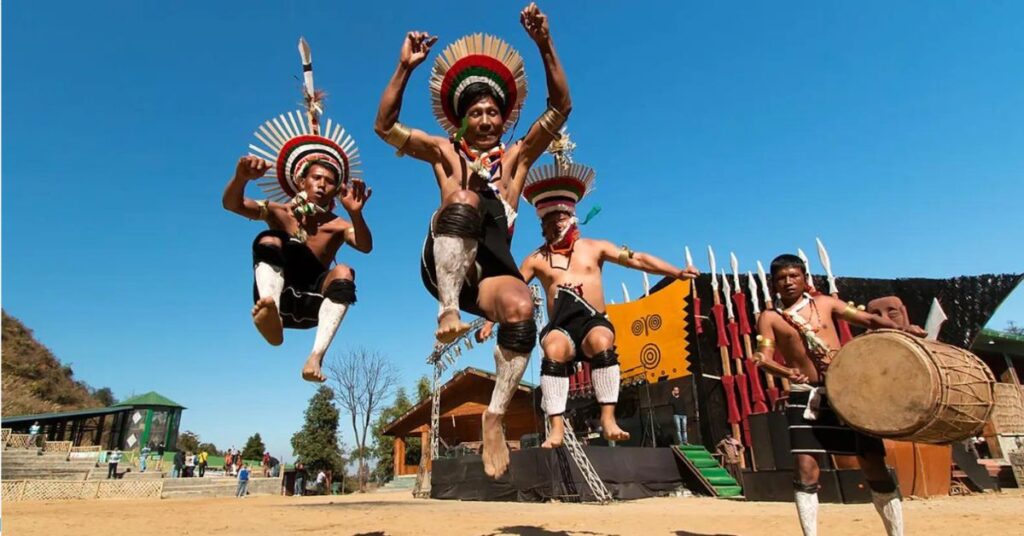
Stepping into Kisama Heritage Village is like stepping back in time. Here, the traditional Naga huts aren’t just impressive buildings – they’re living museums showcasing the rich cultures of Nagaland’s tribes. Each tribe has its own unique style, and the huts are built with care to reflect that. From the materials used to the way they’re decorated, these huts tell a story.
Wander through the village and explore these fascinating structures. You’ll see thatched roofs that keep out the rain, and intricately carved wooden posts that hold everything up. It’s a chance to understand how the Naga people used to live, what their daily lives were like, and the traditions they hold dear. These huts are a window into the heart of Naga culture, offering a glimpse into the past that’s still very much alive.
Tribal Museums and Art Galleries:
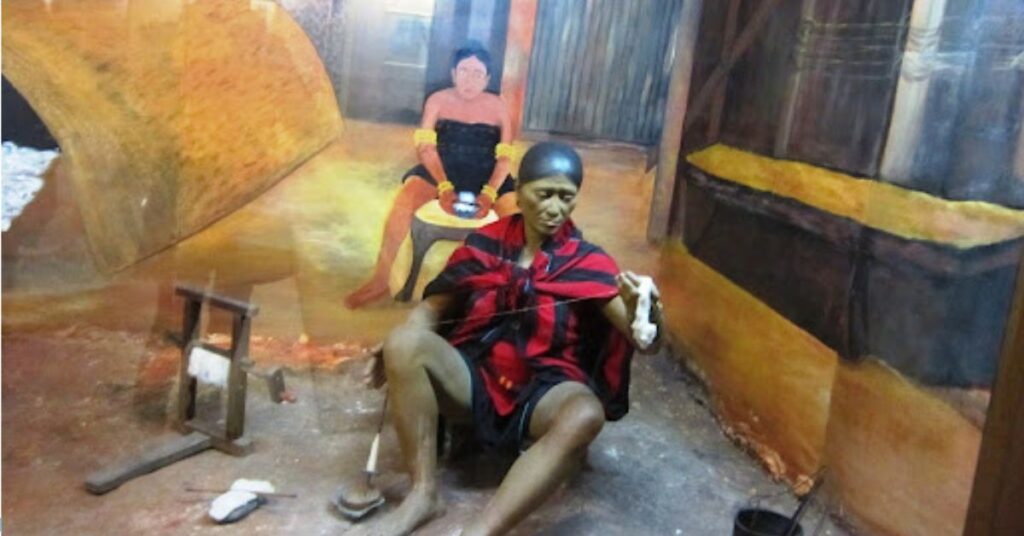
Unveiling the stories of Nagaland’s tribes, Kisama Heritage Village boasts several museums and art galleries. Here, you’ll find a treasure trove of Naga artifacts and artworks, each piece whispering tales of the past. Handwoven textiles in vibrant colors, masks used in ceremonies, and everyday tools – these objects bring the rich cultural heritage of the Naga people to life.
The museums aren’t just displays; they’re educational journeys. Through informative exhibits, you’ll discover the history, art, and craftsmanship of different Naga tribes. Learn about their cultural practices, how they’ve evolved over time, and the stories behind the intricate designs on everyday items. Each artifact is a testament to the artistry and rich history of the Naga people, waiting to be appreciated and understood.
Historical Monuments:
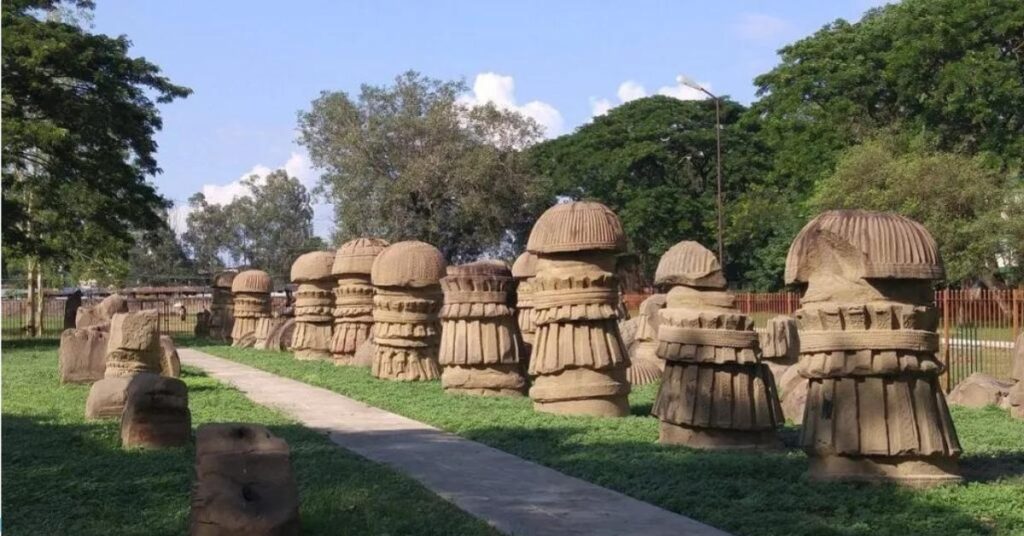
Unveiling the rich history of the Naga people, Kisama Heritage Village is dotted with historical monuments. These aren’t just statues – they’re stories carved in stone. From intricate carvings to war memorials, each monument whispers tales of the Naga tribes’ struggles, triumphs, and cultural journey. Explore these powerful symbols and gain a deeper understanding of their evolution. Standing beside these historical markers, you’ll feel a sense of pride and respect for the Naga people’s heritage, adding another layer to your experience at Kisama Heritage Village.
local experiences:
- Join the Celebration: Immerse yourself in the electrifying Hornbill Festival, or experience the joy of local festivals bursting with traditional dances, music, and rituals.
- Step Inside History: Visit and explore traditional Naga huts, each with its unique architectural style, reflecting the rich cultural heritage of different tribes.
- Live Performances: Be captivated by traditional Naga dances, music, and storytelling sessions, showcasing the artistic expressions passed down through generations.
- Treasure Hunt: Browse through stalls overflowing with beautiful Naga crafts like handwoven textiles, jewelry, and carvings. Don’t forget to sample local delicacies like smoked pork, bamboo shoots, and rice beer!
- Culinary Journey: Learn the secrets of Naga cuisine by joining cooking classes or demonstrations, where you can understand the region’s unique culinary practices.
- Unveiling History: Explore museums and art galleries housing a collection of fascinating Naga artifacts, including traditional clothing, weapons, and ceremonial items.
- Nature’s Embrace: Hike along scenic nature trails surrounding Kisama, and soak in the beauty of lush landscapes, panoramic views, and the serene environment.
- Live Like a Local: Participate in community activities like traditional games or rituals. Interact with local tribespeople to gain a deeper understanding of their way of life.
- Witness Ceremonies: Observe, and if possible, participate in traditional rituals and ceremonies that are central to the cultural and spiritual practices of the Naga tribes.
- Heritage Walks: Join guided tours around the village to learn about the historical and cultural significance of various sites and structures.
- Monuments and Memories: Explore historical monuments and memorials that stand as testaments to the rich heritage and achievements of the Naga people.
travel tips:
Hornbill Festival (Dec 1-10): Book early for accommodation & transport!
Inner Line Permit (ILP): Get yours online or at designated offices (required for entry).
Pack Smart: Comfy clothes, sturdy shoes, weather-appropriate attire.
Cash is King: ATMs limited, so carry cash for purchases.
Stay Healthy: Stick to bottled water, pack meds & a first-aid kit.
Respect the Culture: Dress modestly, be mindful of customs & traditions (especially during ceremonies).
Getting Around: Use local taxis or shared transport (limited public options).
Weather Watch: Check forecasts, especially during monsoon (June-September).
Local Guides: Gain deeper insights with local guides.
Eco-Friendly Travels: Stay on designated trails, avoid littering, support conservation.
Stay Connected: Check mobile coverage, consider a local SIM card.
Document Your Trip: Take photos & notes (always ask permission before photographing people).
conclusion
Unveiling the rich tapestry of Nagaland’s heritage, Kisama Heritage Village is a treasure trove of cultural experiences waiting to be explored. Plan your adventure with Xplro.com, your ultimate travel companion. Kisama caters to every traveler’s curiosity. Immerse yourself in the electrifying Hornbill Festival, a vibrant celebration of dance, music, and local cuisine. Marvel at the intricate beauty of traditional Naga huts, each a testament to a unique tribe’s craftsmanship. Explore bustling markets overflowing with local crafts and savor the flavors of Naga cuisine, a true journey for the senses.
faqs
1. What is Kisama Heritage Village?
- Kisama Heritage Village is a cultural destination located near Kohima, Nagaland, dedicated to preserving and showcasing the diverse traditions and heritage of the Naga tribes. It features traditional Naga huts, cultural exhibits, and is renowned for hosting the Hornbill Festival.
2. When is the ideal time to visit Kisama Heritage Village?
- The ideal time to visit Kisama Heritage Village is during the Hornbill Festival, held from December 1st to 10th. This festival highlights Naga culture through performances, music, and crafts. For a quieter visit with pleasant weather, consider going between October and November or from March to May.
3. How can I reach Kisama Heritage Village?
- Kisama Heritage Village can be reached from Dimapur and Kohima. The nearest airport is Dimapur Airport, about 75 km away. You can take a taxi or bus from Dimapur to Kisama. It’s roughly a 12 km drive from Kohima, with local taxis and buses available.
4. Is a permit required to visit Kisama Heritage Village?
- Yes, an Inner Line Permit (ILP) is required to visit Nagaland, including Kisama Heritage Village. The ILP can be obtained online or from designated offices in Assam and Nagaland.
5. What are the main attractions at Kisama Heritage Village?
- Attractions include the Hornbill Festival, traditional Naga huts representing different tribes, tribal museums with artifacts, cultural performances, craft and food stalls, traditional rituals, scenic trails, and opportunities for community engagement.
6. What types of accommodations are available near Kisama Heritage Village?
- Nearby accommodation options include hotels, guesthouses, and homestays in Kohima and Dimapur. It’s advisable to book your stay ahead of time, especially during peak festival periods.
7. What local dishes should I try at Kisama Heritage Village?
- Sample traditional Naga foods such as smoked pork with bamboo shoots, fermented soybeans (axone), and locally brewed rice beer. These are often available at food stalls during festivals and local events.
8. Is Kisama Heritage Village safe for visitors?
- Kisama Heritage Village is generally safe for tourists. However, it’s always prudent to follow general safety guidelines, like staying in well-populated areas and keeping your belongings secure.
9. What should I pack for a visit to Kisama Heritage Village?
- Pack comfortable clothing suited to the weather, sturdy walking shoes, a rain jacket if traveling during the monsoon season, and basic medications. Carrying cash is also recommended, as card facilities may be limited.
10. Are credit or debit cards accepted at Kisama Heritage Village?
- While some places might accept credit or debit cards, it’s advisable to carry cash, as card payment options may be limited, particularly in more remote areas.
11. Are there any cultural norms or etiquette to follow while visiting Kisama Heritage Village?
- Respect local customs by dressing modestly, asking for permission before taking photos of individuals, and being mindful of local rituals and traditions. Engaging respectfully with the community will enhance your visit.
12. What activities are available at Kisama Heritage Village beyond sightseeing?
- In addition to sightseeing, visitors can participate in traditional dance and music sessions, join cooking classes, explore nature trails, engage in community activities, and shop for traditional crafts and souvenirs. Interaction with local tribespeople provides deeper cultural insights.




